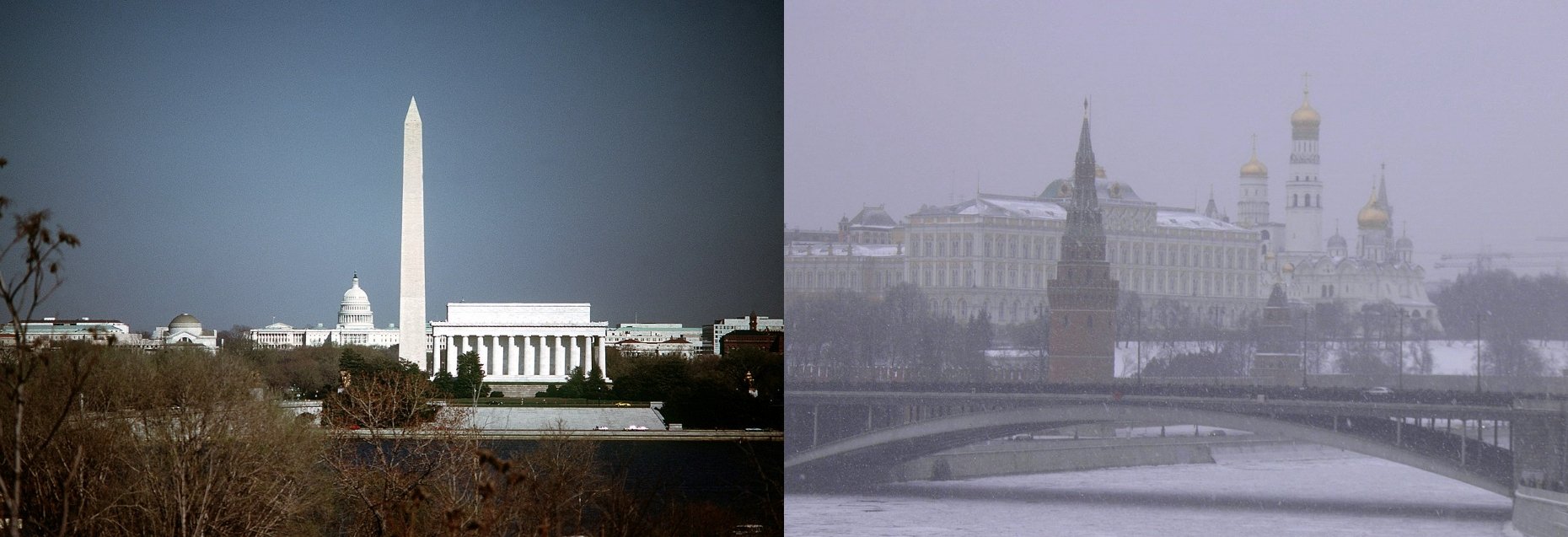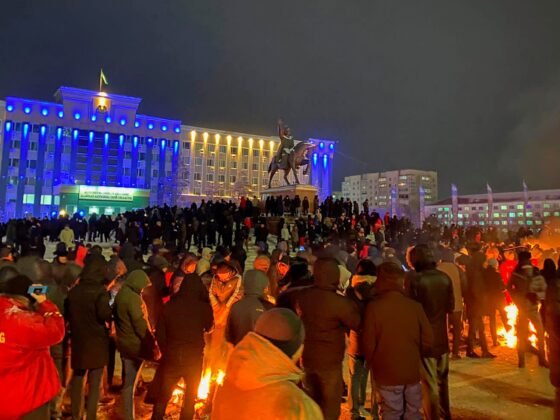(PONARS Eurasia Policy Memo) The year 2021 drew to an end with alarming reports of a build-up of Russian ground forces on the borders of Ukraine and a flurry of speeches by Russian leaders, media figures, and experts threatening military action. Western opinion has been divided over whether President Vladimir Putin’s bellicose stance should be rewarded by concessions over NATO’s presence in Eastern Europe. This memorandum aims to explain why U.S.-Russian relations have reached this parlous state one year into the Biden administration.
In his 2007 speech to the Munich security conference, Putin signaled that he was unhappy with the European security architecture. He argued that NATO’s eastward expansion violated promises made at the time of German unification in 1990 and that Western sponsorship of “color revolutions” in the former Soviet republics was a threat to Russian security. There was no change in Western policy, so Putin responded with military force in Georgia (2008) and Ukraine (2014). In 2021, with a new administration in the White House, the Kremlin seemed to have decided to try to resolve the issue of the security of Russia’s western borders once and for all.
The Strategic Context
Putin is confident that he has the military, economic and political capacity to force major concessions from the West. Russia’s military action in Georgia and Ukraine did not meet with a decisive Western response. The sanctions imposed after the annexation of Crimea were limited in scope and, at best, shaved one percent off Russia’s annual GDP growth. They actually helped Putin achieve some of his domestic policy goals—reining in the oligarchs and reviving Russian agriculture.
While the United States hung back in Syria, Russia’s military intervention in 2015 rescued the Assad regime and brought Russia back as a key player in the Middle East. The election of Donald Trump in 2016 and his chaotic presidency, culminating in the January 6, 2021, Capitol riot, exposed the fragility of U.S. democracy and eroded U.S. capacity to speak as a moral authority on the world stage. The withdrawal of U.S. troops from Afghanistan in August 2021 and the return to power of the Taliban was the biggest setback for U.S. foreign policy since the 9/11 attacks. Meanwhile, the EU was weakened by the exit of Great Britain in January 2020 and the departure of German Chancellor Angela Merkel in November 2021 after 16 years. Meanwhile, Russia compensated for the deterioration in relations with the United States and Europe by deepening economic and strategic partnership with China.
The aggressive turn in Russian foreign policy is often explained as the strategy of a corrupt ruling clique to cling to power by diverting public attention from economic stagnation at home. This diversionary theory is unconvincing: although the annexation of Crimea boosted Putin’s popularity, a majority of Russians oppose further military intervention in Ukraine. Putin is not worried about public opinion; he is concerned about his historical legacy as a leader capable of reversing the strategic setback of the Soviet collapse.
On the U.S. side, President Joe Biden pursues a foreign policy driven by the economic interests of “middle-class America,” alongside a rhetorical return to Wilsonian universal values on the global stage and a new emphasis on countering Chinese expansion. That complex and contradictory combination leaves little space for Russia to find common ground with the United States, in either interests or values. Russia sees the “summit of democracies” that Biden convened in December 2021 as an example of the US’s aspiration to global hegemony and willingness to use democracy as a tool to destabilize other countries.
Off to a Shaky Start
When Biden was inaugurated in January 2021, U.S.-Russian relations were in poor shape, arguably at the lowest point since the fall of the Soviet Union. The narrative of Russian interference in the 2016 election and Trump’s unwillingness to criticize Putin were constant themes in U.S. domestic political debates. At the same time, there were grounds for cautious optimism. A new president meant a chance for a fresh start—and the opportunity to blame the poor state of relations on the previous administration. Putin saw Biden as an experienced, pragmatic leader who might be open to making a deal—and who, unlike Trump, would be capable of seeing it through. Putin described his first phone call with Biden on January 26, 2021, as “open and businesslike” and said, “normalization of relations would suit the interests of both sides.”
The two men agreed to extend the 2011 New START agreement, limiting the two countries’ nuclear arsenals, for five more years—otherwise, the treaty would have expired on February 5. However, relations quickly soured. Oppositionist Alexei Navalny was arrested on his return to Moscow on January 17 and then sentenced to three years in jail. It was presumably the Navalny case that Biden had in mind when he called Putin a “killer” in a television interview in March. Soon after, Russian state media launched “a full-scale war” on the U.S. president.
The Navalny case, plus the release of further information about the 2020 SolarWinds hack that affected private companies and U.S. federal agencies, led the Biden administration to impose new sanctions on Russia on March 2 and April 15. They included bans on individuals and entities involved in various hacking campaigns, limits on purchasing Russian government bonds, and the expulsion of ten diplomats. The Kremlin retaliated by expelling ten U.S. diplomats and banning Russian citizens from working in U.S. diplomatic facilities, crippling consular operations. In May, Russia issued a list of foreign countries that had engaged in “unfriendly actions” toward Russia and blocked their embassies from hiring local staff. There were only two countries on the list: the United States and the Czech Republic. (The latter had accused Russia of being behind an explosion at a Czech arms depot in 2014).
Russia was angered by what they saw as Ukrainian President Volodymyr Zelensky’s intransigence over the implementation of the 2015 Minsk II accords and by his decision in February to shut down the television stations of the pro-Russian oligarch Viktor Medvedchuk. (In May, Medvedchuk was put under house arrest and accused of treason.) In April, Russia massed 100,000 troops on the Ukrainian border in what looked like preparations for an invasion. In response, Biden called Putin on April 13 and proposed to meet face to face in Geneva on June 16—the first summit between the Russian and U.S. presidents since July 2018.
The Geneva Summit
There were cautious hopes that Geneva could mark a turning point, opening the door to an improvement in relations. The relatively restrained tone of commentary in the Russian media[1]—carefully curated by the Kremlin—suggests that Putin was ready for better relations with the West. Russian media did not present Biden as someone looking to undermine Putin, but rather as a president who understood Russia’s “red lines” and was willing to talk and make a deal. Of course, media coverage does not provide direct insight into the real goals of the Kremlin. It merely tells us how the leadership is framing Russian foreign policy for the domestic audience.
Although several important issues, such as cybersecurity, trade, regional conflicts, and strategic stability were discussed, no documents were signed. The two sides were talking to each other. But were they listening?
The first tangible results were the return of ambassadors in June, a meeting in Geneva on arms control on July 18, and a July visit to Moscow by John Kerry to discuss climate change. There was no progress regarding the implementation of the 2015 Minsk II agreement aimed at resolving the conflict in eastern Ukraine (and to which Washington was not a signatory). Moscow demands constitutional changes granting special status to the secessionist Donbas regions before allowing Kyiv to establish control over the border with Russia, while Kyiv insists that restoring Ukraine’s control over its own territory must come first. Tension ratcheted up in June when a British destroyer conducted a “freedom of navigation” exercise through the waters around Crimea.
Clashing Interests in Europe
Biden’s policy toward Eastern Europe has been described as one of “benign neglect.” The strategy is to maintain the status quo while diverting U.S. resources to domestic reconstruction and the contest with China. The problem with this approach is that the status quo is not stable. Political crises are gripping Belarus and Ukraine, and Russia itself has become ever more vocal about its desire to halt and even reverse NATO expansion. It regards the current situation of a “NATO presence” in Ukraine, supplying weapons and providing training, as unacceptable. In November 2021, Putin said he regards NATO anti-missile batteries in Poland and Romania as an offensive threat to Russian security, drawing the parallel with the U.S. reaction when Soviet missiles were placed on Cuba back in 1962.
While the United States was trying to dial down its commitments to Europe, Russia was dialing them up, applying pressure on multiple fronts. In August, thousands of migrants from Iraq and other destinations flew to Minsk and started trying to cross the border into Poland, seeking asylum. In November, Russia again moved into position on its border with Ukraine some 100,000 troops, including heavy equipment. Defense Minister Sergei Shoigu said 120 American contractors are working in Ukraine with chemical weapons. He claimed that in 2015 the United States gave chemical weapons to rebels in Syria and, when they were deployed, used that as an excuse to strike Syrian government forces.
The bellicose rhetoric in Russian media reached a fever pitch. On November 15, Russia blew up one of its own satellites, creating a cloud of dangerous debris. Television host Dmitrii Kiselev boasted, “By stepping over the ‘red line,’ NATO risks losing all 32 GPS satellites at once, which will blind all their missiles, planes and ships.” Colonel Konstantin Sivkov, the deputy president of the Russian Academy of Rocket and Artillery Sciences, said in a December 9 television interview that “160 SLBMs could turn a country like Germany into a nuclear wasteland.” A group sang a song in praise of nuclear missiles for space agency officials, one of the lines being “missiles don’t need a visa.” A military expert explained that “ten Sarmat [missiles] could wipe out the American population.”
Energy Showdown
At the same time, Russia took advantage of a spike in global natural gas prices to pressure the EU to approve the Nordstream 2 pipeline and to return to the previous policy of long-term contracts with Gazprom.
On July 21, the U.S. and German governments issued a joint statement affirming support for the pipeline, conditional on Russia not using energy as a political weapon and pledging a $1 billion “green fund” for Ukraine. Russia’s many critics in Congress pushed back, led by Senator Ted Cruz, who put a hold on over 30 ambassadorial appointments. Biden introduced some additional sanctions targeting individuals and companies affiliated with the project in August and promised to put Nordstream sanctions to a vote in the Senate in early 2022. By September 2021, the construction of the pipeline was finished, but it still faced regulatory hurdles. In August, a German court decided that the pipeline did not meet European standards for separating suppliers and pipeline owners, as required by the 2009 Third Energy package. In November, the German regulator reported that the ownership structure remained out of line with the legal requirements.
A complicating factor was the political transition in Germany. The Social Democrats emerged as the leading party in the September 26 election, but it took two months of bargaining before they were able to form a coalition government with the Greens and Free Democrats. The Greens are opposed to Nord Stream 2—but it is hard to see how the new government will realize its ambitious climate change goals (phasing out coal by 2030) without increased supplies of Russian gas in the interim.
While the Nordstream saga dragged on, Russia increased the pressure on the EU by cutting back on gas sales on the spot market, which made it difficult for suppliers to build up the reserves for the winter. That, combined with a revival of growth in the global economy in 2021, led to a surge in global gas prices. The European natural gas price increased 350 percent from April to December. High gas prices in Asia meant not enough surplus LNG on the global market.
Since 2019 the EU has encouraged customers to switch away from long-term contracts with Gazprom (where the price is typically tied to a six-month moving average of the oil price). This reflects the belief that spot markets offer more flexibility and choice and make it easier for liquefied natural gas (LNG) deliveries from outside the continent. The United States is keen to export LNG to Europe. Financial firms also lobbied for the switch since it enables them to profit from the gas futures market. Russia, in contrast, argues that long-term contracts are necessary to guarantee stable prices and make a possible investment in long-term supplies.
The impoverished country of Moldova was the first casualty of the gas war. The old Gazprom contract price was $300 per 1,000 cms, but the new spot price on October 1 was $700. President Maia Sandu’s pro-EU party won parliamentary elections in July, but it was forced to cave and sign a new five-year contract with Gazprom on October 29. The EU’s foreign policy chief Josep Borrell described Gazprom’s approach as “weaponization of the gas supply.”
What Does Russia Want?
In the course of 2021, Putin seems to have concluded that Russia is losing the geopolitical struggle with the West for control over Ukraine and has to take a new approach before NATO is able to introduce a military presence in that country. Russian propaganda changed tack, denouncing Zelensky as a puppet of the West and culminating in the extraordinary essay that Putin published in July in which he denied Ukraine’s right to exist as a sovereign state. Russia also claimed that Ukraine was planning to launch an offensive to retake Donbas, possibly inspired by Azerbaijan’s success in 2020 in capturing most of the territories occupied by Armenia. Ukraine, like Azerbaijan, has bought Bayrakter TB2 drones from Turkey—and used one to destroy a howitzer in Donbas in October 2021.
The prevailing assumption is that Putin’s massing of troops on Ukraine’s border is just intended to force concessions from the West (ignoring the adage that “great powers do not bluff”). Putin does not want a war, but he is prepared to go to war if the West does not recognize the “red lines” which he has drawn defining Russia’s vital security interests. Putin complained in a November 18 speech that “our partners are peculiar in the sense that they have a very—how to put it mildly—superficial approach to our warnings about red lines.” Biden and Putin held a video conference on December 7, in which Putin warned that NATO “is making dangerous efforts to gain a foothold on Ukrainian territory.”
On December 17, Russia published its list of security demands, including an end to NATO enlargement, the withdrawal of military infrastructure placed in Eastern Europe since 1997, and a halt to all military activities in countries neighboring Russia. The demands were described as an integrated package, not an “a la carte menu,” though Putin later denied that they were an “ultimatum.”Fyodor Lukyanov warned that “we can expect Moscow to take steps demonstrating Russia’s determination to unilaterally change the status quo.” In his end of the year press conference on December 23, Putin complained, “The United States is placing rockets at our doorstep… How would the United States react if we delivered rockets near their borders with Canada or Mexico?” but he also said that negotiations with the United States are “positive” and “the ball is in their court.”
Were Russian forces to attack Ukraine, they would likely achieve their objectives in days or weeks at best. The United States has no intention of putting its own military into the field to help defend Ukraine. Instead, Biden warned Putin of harsh economic sanctions in the event of a Russian invasion. The most widely discussed action is the exclusion of Russia from the SWIFT bank transfer system, which would severely disrupt international transactions. That is not a problem for the United States, which has minimal trade with Russia, but it is for European countries, which have extensive exports to Russia.
Conclusion
Prospects for some kind of diplomatic reconciliation look slim. As things stand, the minimal conditions of one side are beyond the maximum concessions offered by the other. Russian and U.S. officials have agreed to meet in January. They will have to find a creative solution to the current impasse, one which enables each side to come away claiming a political victory that they can then proclaim to their respective domestic constituencies and foreign partners. Presumably, by insisting on dealing bilaterally with the United States, Putin is assuming that if Washington concedes, the Europeans will swiftly fall into line, not least because of their precarious dependence on Russian gas imports.
Peter Rutland is the Colin and Nancy Campbell Professor in Global Issues and Democratic Thought in the Government Department at Wesleyan University.
[1] Relevant pieces in three media outlets, Izvestiia, Gazeta,and Vladimir Soloviev’s television program Telegram, were reviewed for the month before and the month after the Geneva summit.
PONARS Eurasia Policy Memo No. 731











